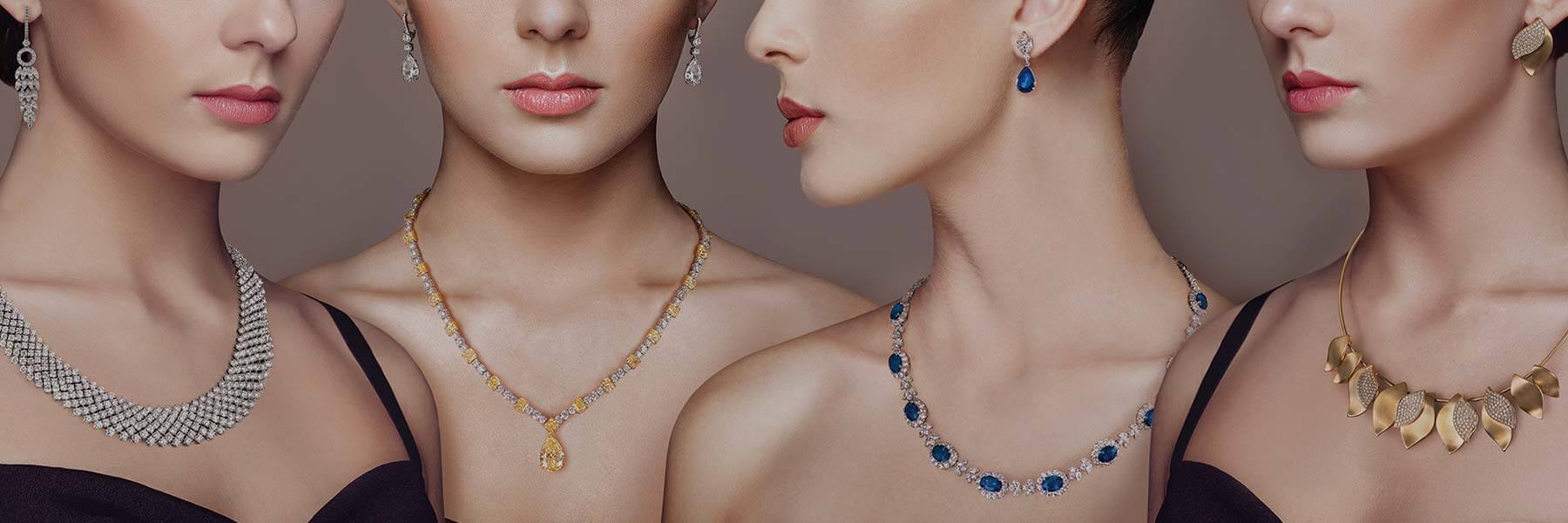Time Machine

The Timeless Appeal of Vintage Watches
Even casual observers of watch collecting couldn’t help but have noticed the popularity and influence of vintage timepieces in the past decade. Paul Newman’s Rolex Daytona famously sold at auction for over 17 million dollars. Financial advisors are recommending watches as material investment strategies. Even among the biggest brands like Tudor, Omega, and Panerai, heritage inspired designs find their way into the latest novelties. Nostalgia is popular right now, for a number of reasons, and there’s nothing more nostalgic than a vintage watch on your wrist.
SUSTAINABLE MEMORIES
The mechanical wristwatch is a model of sustainability and of lasting value in a world of ever increasing disposability. Maintained and treated well, it can be worn daily almost in perpetuity, passed down through generations. What other manmade object has such lasting appeal, charm and yes, utility? Cars rust away and are discarded. Clothing falls victim to the moth, the ravages of time, and shifting fashions. But a wristwatch, first worn by a soldier, a pilot, a scientist, or an actor decades ago, will still tell you the time, ticking on your wrist daily. This durability and, shall we say, timelessness are part of the appeal of owning a vintage watch.
Strap on a Rolex Submariner from the 1960s, an Omega chronograph from the early ’70s or even a classic Cartier from the ’40s and the timepiece ties you to a lineage of those who wore it before, even if you have no idea who its previous owners were. The imagination runs wild. Where was it first acquired? A dive shop in Long Beach perhaps, or a Navy PX in the Philippines, maybe a jeweler in Zurich for a special occasion. Even when the origins or provenance are not known, the speculation is endlessly intriguing. Sometimes a caseback is cryptically engraved with a date, maybe some initials, a dedication, or a declaration of love. A prominent dent is a mystery never to be solved, yet leads to countless theories.
A watch is a tangible collector of memories. The mere fact that it is powered by its wearer, either through hand winding or the movement of the arm, and marches out the passage of time, is more than metaphor. Every scratch on the case is a scar, a reminder of a hike, a dive to a shipwreck, the birth of a child, a new house, the achievement of a job or a college degree. When we acquire a vintage timepiece and continue to wear it, we make it our own, adding to that collection of memories and move it forward in time, until we pass it on to someone else.
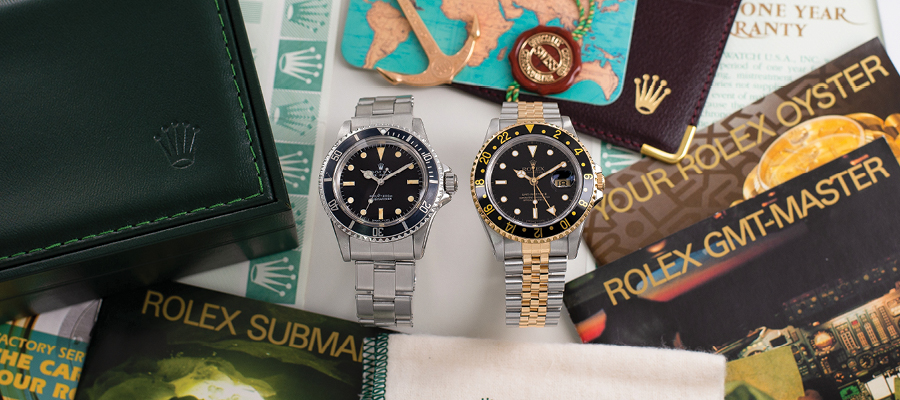
Left–1975 Rolex Submariner, Right–1991 Rolex GMT-Master II
CAVEAT EMPTOR
If you’re not lucky enough to acquire a vintage watch through family inheritance or finding it buried in the sand on a beach, odds are you’re going to be buying it. And that can be a daunting proposition, a confusing minefield of botched restorations, questionable provenance, fake components, and mechanical can of worms. With a new watch, you more than likely purchase it through an authorized dealer, with the built-in assurances of authenticity and reliability. But wading into the realm of vintage timepieces, things are less clear. The rising value of vintage watches in recent years has brought forth the predictable crop of less than scrupulous sellers with watches often composed of a mish-mash of cobbled parts—so called “Frankenwatches”— inexpert restorations and servicing, and inflated prices. The best advice to anyone seeking to buy vintage is, “buy the seller before you buy the watch.”
Two watch words for those looking to get into vintage are, “originality” and “condition.” Seasoned collectors will tell you that a scratched up and faded watch that hasn’t had new hands and dial fitted, or the case polished smooth, will be more desirable and valuable in the long term, over one that has been excessively restored. This may seem contrary to our modern sensibilities that tell us to make old things new again. But it also doesn’t mean the watch is neglected. It’s borderline criminal to leave a mechanical watch’s movement unserviced, its oils dried up and its seals disintegrated. It is a fine balance.
BUY THE SELLER
Wixon Jewelers has many years of experience with vintage watches. Founder Dan Wixon himself is a longtime passionate collector, and the store’s service department has seasoned watchmakers who’ve been entrusted by loyal customers to keep their heirlooms running. Servicing vintage watches is not as straightforward as with modern timepieces. Some owners prefer to keep dials and hands untouched, preserving their hard won patina. Others feel the same with the case itself, asking that the metal not be polished, favoring the scratches and dents that come with decades of regular wear. Sourcing original replacement parts can be challenging, and in some situations, it can be necessary to craft movement components for obsolete watch references, an art in itself. And while we never recommend taking vintage dive watches underwater, some of our customers (this author included) have requested an old Submariner be brought up to original spec so it can carry on its intended purpose.
Wixon sources its inventory from various places, but often from trades or purchases from existing clientele. In every case, all watches for sale in the vintage showcase have been scrutinized for authenticity, originality and then examined and serviced for impeccable functionality. As a long time Rolex and Patek Philippe retailer, Wixon favors those brands for vintage sales, but also carries historic Heuers, Omegas, and other important marques, all receiving the same meticulous care and attention.
AN INVESTMENT YOU CAN WEAR
As vintage watch values continue to climb, a timepiece from a reputable Swiss brand can be a legitimate addition to an investment portfolio. Of course, as with any investment, there’s no predicting the future, but particularly watches from Patek and Rolex have seen steady gains in the recent past, to the point where they can almost be called a “sure bet.” But the beauty of this kind of investment is, a watch is one that can be worn and enjoyed, whether for special occasions or even as a daily companion. And by doing so, you add to its history and its provenance, while it times the important moments of your life, and those to whom you pass it on. It is, quite literally, a time machine.
Collectible Characteristics
PATINA
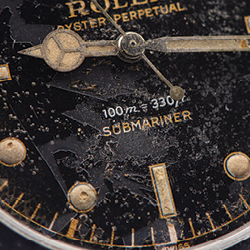 Referred to as patina, this wear demonstrates that the watch has led an interesting life and has not been overly restored– originality is a feature that collectors prefer. Plus, patina creates a unique beauty that simply cannot be replicated.
Referred to as patina, this wear demonstrates that the watch has led an interesting life and has not been overly restored– originality is a feature that collectors prefer. Plus, patina creates a unique beauty that simply cannot be replicated.
SPIDER DIAL
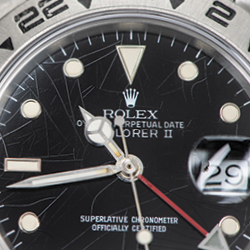 A spider dial is a special type of aging that occurred on the early glossy dials which led some dials to experience a cracking or crazing effect. This was typically corrected by Rolex at subsequent servicing so it is not something we see very often!
A spider dial is a special type of aging that occurred on the early glossy dials which led some dials to experience a cracking or crazing effect. This was typically corrected by Rolex at subsequent servicing so it is not something we see very often!
TROPICAL DIAL
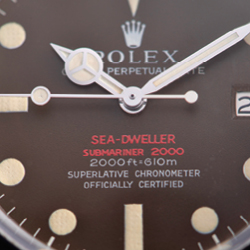 Sporting an evenly faded dark chocolate tone, this unusual byproduct of age is the byproduct of intense exposure to UV light. A Tropical dial is highly coveted by collectors due to the rarity, uniqueness, and aesthetics of the uniform color change.
Sporting an evenly faded dark chocolate tone, this unusual byproduct of age is the byproduct of intense exposure to UV light. A Tropical dial is highly coveted by collectors due to the rarity, uniqueness, and aesthetics of the uniform color change.
Jason Heaton has a decade-long history of adventure, travel and wristwatch writing, and his work has appeared in Gear Patrol, Men’s Journal, Wired, Revolution, and Hodinkee. The New York Times once called him, “a test pilot for the world’s most illustrious undersea timepieces.” He is also a published novelist and the co-host of the popular podcast, The Grey NATO. Since 2015, he has been a member of the prestigious Explorers Club. He lives with his wife, Gishani, and their cat in Minneapolis.
[Top Image]: Left–1940’s Patek Philippe Calatrava Ref. 1597R, Right–1952 Rolex Oyster Chronograph



